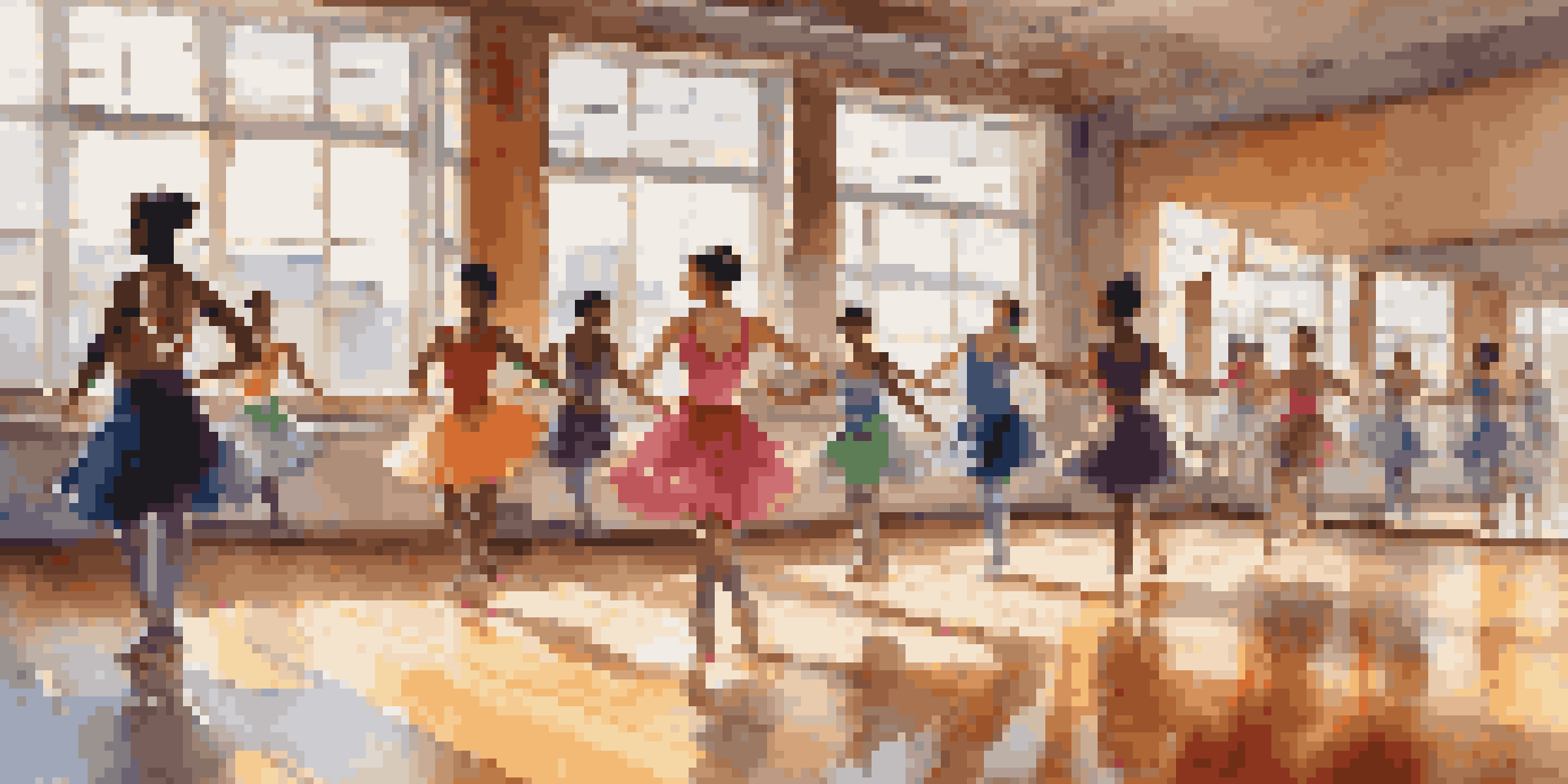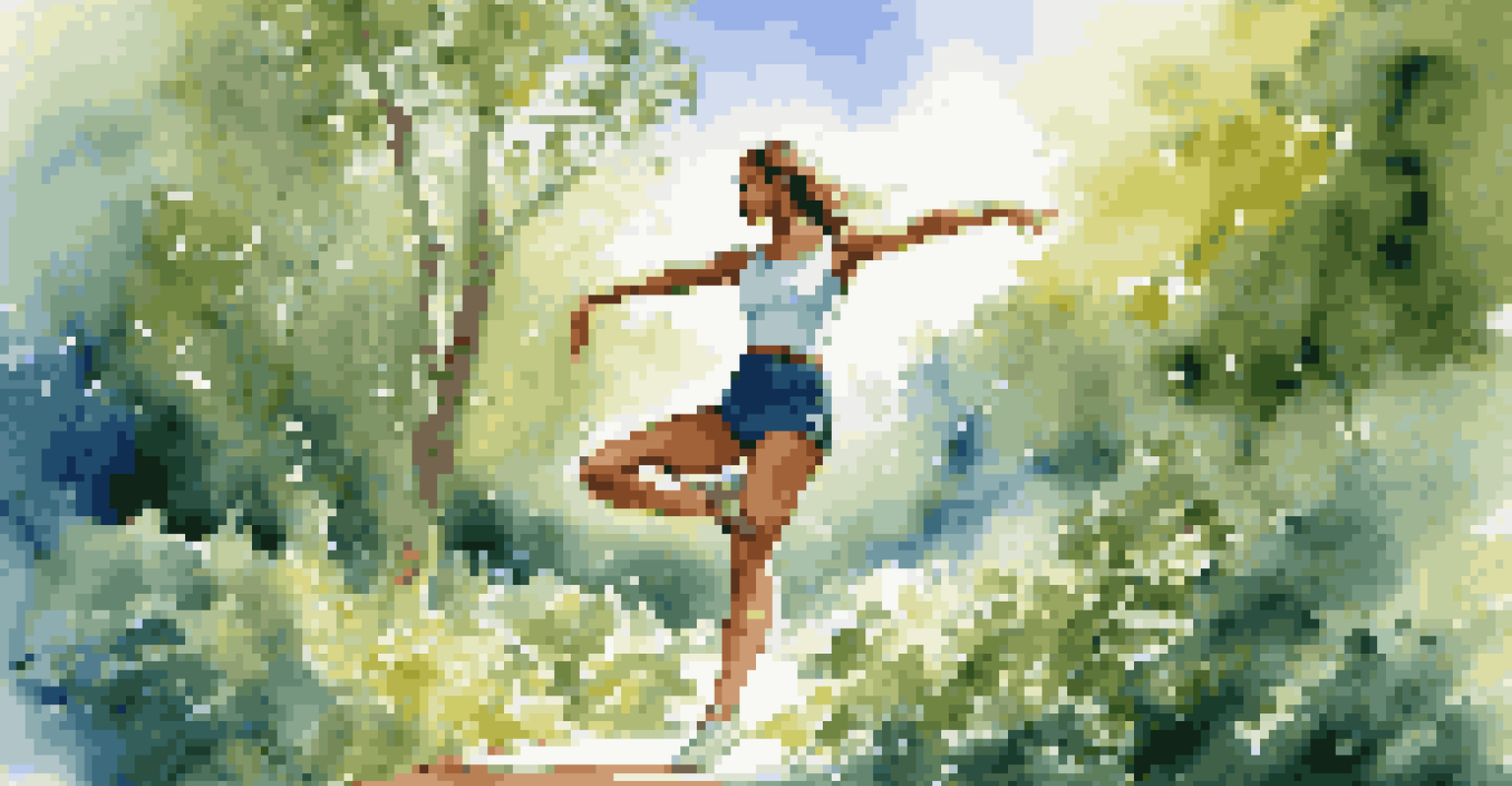Dance Influencers: Shaping the Landscape of Modern Dance

The Rise of Dance Influencers in the Digital Age
In recent years, dance influencers have emerged as pivotal figures in the dance community. With platforms like Instagram, TikTok, and YouTube, dancers can showcase their talent and connect with audiences globally. This digital shift has transformed how dance is perceived, allowing influencers to reach millions instantly.
Dance is the hidden language of the soul.
Unlike traditional dancers who often perform in studios or theaters, these influencers bring dance into everyday life. They share quick tutorials, behind-the-scenes content, and creative choreography that inspires followers to join in. This accessibility has democratized dance, making it enjoyable and understandable for everyone, regardless of skill level.
Moreover, dance influencers often blend styles and genres, pushing the boundaries of what dance can be. This innovation not only keeps the art form fresh but also encourages collaboration among dancers from diverse backgrounds, fostering a vibrant and inclusive dance culture.
Impact of Social Media on Dance Styles and Trends
Social media has dramatically influenced dance styles and trends, often leading to rapid shifts in what’s popular. Influencers regularly use viral challenges to introduce new moves, which can quickly catch on with their followers. This phenomenon means that a single video can set off a new dance trend overnight, showcasing the power of digital platforms.

For example, the 'Renegade' dance, created by youth influencer Jalaiah Harmon, became a nationwide sensation largely due to its exposure on TikTok. Such trends not only highlight the creativity of young dancers but also create a sense of community as people worldwide participate and share their versions. This interconnectedness has redefined dance culture, making it more collaborative than ever.
Dance Influencers Redefine Accessibility
Dance influencers are making dance education more accessible through online tutorials and classes that cater to all skill levels.
Additionally, many influencers utilize their platforms to explore and blend various dance styles, which encourages followers to experiment with different genres. This fusion of styles not only keeps dance exciting but also allows for cultural exchange and appreciation, enriching the dance landscape.
Building Communities Through Dance Influencers
Dance influencers are not just entertainers; they are community builders. Through their content, they foster a sense of belonging among followers who share a passion for dance. Whether it’s through virtual classes or interactive challenges, influencers create spaces where dance enthusiasts can connect, learn, and grow together.
The only way to make sense out of change is to plunge into it, move with it, and join the dance.
For instance, many influencers host live sessions where they teach choreography or offer feedback on followers’ dance videos. This direct engagement not only helps dancers improve their skills but also strengthens the community bond. Followers often feel more motivated and inspired when they see their favorite influencers actively supporting and interacting with them.
Moreover, these communities often extend beyond dance, addressing issues like mental health and self-expression. Influencers frequently share personal stories and struggles, creating a more relatable and authentic atmosphere, which resonates deeply with their audience and encourages open dialogue.
The Role of Dance Influencers in Education and Access
Dance influencers play a crucial role in making dance education more accessible than ever. Through online tutorials and classes, they provide resources that allow anyone to learn dance from the comfort of their home. This accessibility is particularly significant for those who may not have access to traditional dance studios or instructors.
Platforms like YouTube and Instagram host countless free dance lessons, ranging from beginner to advanced levels. Influencers often break down complex moves into manageable steps, making it easier for learners to grasp and replicate. This approach not only demystifies dance but also empowers individuals to express themselves through movement.
Social Media Drives Dance Trends
Social media platforms enable dance influencers to rapidly introduce new styles and trends, creating a collaborative and interconnected dance culture.
Furthermore, many influencers collaborate with established dance educators to create comprehensive courses that blend fun with technique. These collaborations enhance the learning experience, ensuring that aspiring dancers receive quality education while still enjoying the creative process.
Monetization and the Business of Dance Influencing
As the dance influencer trend grows, so does the potential for monetization. Many influencers leverage their popularity to partner with brands, creating sponsored content that showcases products relevant to their audience. This symbiotic relationship not only boosts the influencer's income but also helps brands reach a targeted demographic.
For example, dance influencers often collaborate with athletic wear companies, promoting clothing that enhances performance while also looking stylish. These partnerships can be mutually beneficial, as influencers gain financial support while brands connect with passionate dance communities. This trend highlights how dance can be both an art form and a viable career path.
Moreover, some influencers have taken it a step further by launching their own merchandise or dance programs. This entrepreneurial spirit allows them to share their passion while also creating additional revenue streams, further solidifying their place in the dance industry.
Challenges Faced by Dance Influencers Today
Despite their influence, dance influencers face a unique set of challenges in the digital landscape. The pressure to consistently produce engaging content can be overwhelming, leading to burnout and creative block. As trends evolve rapidly, staying relevant requires constant innovation, which can be difficult to maintain over time.
Additionally, the competitive nature of social media can lead to negative comparisons and self-doubt among influencers. Many struggle with the notion of ‘likes’ as a measure of success, which can overshadow their passion for dance. This external validation can create a toxic environment that detracts from the joy of creating.
Community Building Through Dance
Dance influencers foster communities by engaging with followers through virtual classes and sharing personal stories, creating a sense of belonging among dance enthusiasts.
Moreover, as the dance influencer scene grows, the risk of appropriation and misrepresentation increases. Dancers must navigate the fine line between inspiration and imitation, ensuring they respect the origins of the styles they showcase. This challenge calls for a greater emphasis on cultural sensitivity and awareness in the dance community.
The Future of Dance Influencers and Their Impact
Looking ahead, the future of dance influencers appears vibrant and full of possibilities. As technology continues to evolve, so will the ways in which influencers share their art. Virtual reality and augmented reality are on the horizon, potentially offering immersive dance experiences that could change how audiences engage with dance.
Additionally, as more dancers enter the digital space, the importance of diversity and representation will become even more critical. Audiences are increasingly seeking authenticity and varied perspectives in dance, which can lead to richer content and broader conversations around the art form. This shift may inspire a more inclusive dance culture that reflects a wide range of experiences.

Ultimately, dance influencers will continue to shape the modern dance landscape, bridging the gap between traditional forms and contemporary expressions. Their ability to inspire, educate, and connect will ensure that dance remains a dynamic and evolving art form for generations to come.